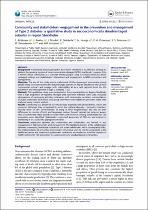| dc.contributor.author | Al-Murani, F | |
| dc.contributor.author | Aweko, J | |
| dc.contributor.author | Nordin, I | |
| dc.date.accessioned | 2022-10-26T12:43:44Z | |
| dc.date.available | 2022-10-26T12:43:44Z | |
| dc.date.issued | 2019 | |
| dc.identifier.citation | F. Al-Murani, et.al. (2019) Community and stakeholders’ engagement in the prevention and management of Type 2 diabetes: a qualitative study in socioeconomically disadvantaged suburbs in region Stockholm, Global Health Action, 12:1, 1609313, DOI: 10.1080/16549716.2019.1609313 | en_US |
| dc.identifier.uri | https://doi.org/10.1080/16549716.2019.1609313 | |
| dc.identifier.uri | http://hdl.handle.net/10566/8079 | |
| dc.description.abstract | Background: Community-based approaches have been identified as an effective strategy to
address the growing burden of noncommunicable diseases (NCDs) worldwide. However, little
is known about community as a concept among people living in socioeconomically disad vantaged settings and stakeholders’ interactions and engagement in NCDs prevention and
management.
Objective: The aim of this study was to understand; (1) the meaning of community among
people living in socioeconomically disadvantaged suburbs in Region Stockholm and (2) how
communities interact and engage with stakeholders at local and regional levels for the
prevention and management of type 2 diabetes (T2D).
Methods: This qualitative study was conducted in three municipalities in Region Stockholm
with a high proportion of migrants. Multiple data collection methods were used, including
observations of community activities; interviews with community members, representatives
of public authorities and NGOs; and group interviews with healthcare providers. Data were
analyzed using content analysis.
Results: Community was perceived as living in close proximity with shared beliefs, values and
resources. Although they recognized its social and cultural diversity, community members
focused more on the commonalities of living in their neighborhood and less on their
differences in country of birth and languages spoken. Several mismatches between aware ness of community needs and the available skills and resources among stakeholders for T2D
prevention were identified. Stakeholders expressed awareness of T2D risk and interest in
addressing it in a culturally appropriate manner.
Conclusion: Interaction between the communities and stakeholders was limited, as was
engagement in T2D prevention and management. This highlights barriers in the collaboration
between community, healthcare institutions and other stakeholders which consequently affect
the implementation of preventive interventions. Innovative ways to link the community to the
healthcare sector and other local government institutions are needed to build the capacity of
health systems for T2D prevention in socioeconomically disadvantaged communities | en_US |
| dc.language.iso | en | en_US |
| dc.publisher | Taylor and Francis | en_US |
| dc.subject | Community | en_US |
| dc.subject | Type 2 diabetes | en_US |
| dc.subject | health promotion | en_US |
| dc.subject | NCD prevention | en_US |
| dc.title | Community and stakeholders’ engagement in the prevention and management of Type 2 diabetes: a qualitative study in socioeconomically disadvantaged suburbs in region Stockholm | en_US |
| dc.type | Article | en_US |

